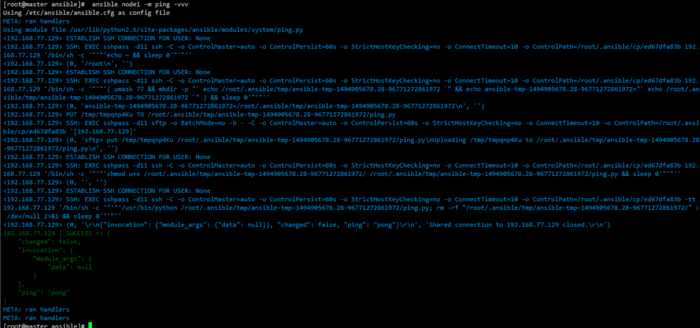一 模块说明
- 官方是否有提供的类似功能模块?
可从下面两个连接确定官方提供的模块,以免重复造轮子
官方已发布的模块 http://docs.ansible.com/ansible/modules.html
官方正在开发的模块 https://github.com/ansible/ansible/labels/module - 你需要开发一个action 插件么?
action插件是在ansible主机上运行,而不是在目标主机上运行的。对于类似file/copy/template功能的模块,在模块执行前需要在ansible主机上做一些操作的。
- 模块是传送到目标主机上运行的。 - 模块的返回值必须是json dumps的字符串。
1 模块执行的过程

首先,将模块文件读入内存,然后添加传递给模块的参数,最后将模块中所需要的类添加到内存,由zipfile压缩后,再由base64进行编码,写入到模版文件内。 通过默认的连接方式,一般是ssh。ansible通过ssh连接到远程主机,创建临时目录,并关闭连接。然后将打开另外一个ssh连接,将模版文件以sftp方式传送到刚刚创建的临时目录中,写完后关闭连接。然后打开一个ssh连接将任务对象赋予可执行权限,执行成功后关闭连接。 最后,ansible将打开第三个连接来执行模块,并删除临时目录及其所有内容。模块的结果是从标准输出stdout中获取json格式的字符串。ansible将解析和处理此字符串。如果有任务是异步控制执行的,ansible将在模块完成之前关闭第三个连接,并且返回主机后,在规定的时间内检查任务状态,直到模块完成或规定的时间超时。
使用了管道连接后,与远程主机只有一个连接,命令通过数据流的方式发送执行。
配置方式
vim /etc/ansible/ansible.cfg pipelining = True
执行过程

Ansible提供了许多模块实用程序,它们提供了在开发自己的模块时可以使用的辅助功能。 basic.py模块为程序提供访问Ansible库的主要入口点,所有Ansible模块必须至少从basic.py导入:
from ansible.module_utils.basic import *
其他模块工具
a10.py - Utilities used by the a10_server module to manage A10 Networks devices. api.py - Adds shared support for generic API modules. aos.py - Module support utilities for managing Apstra AOS Server. asa.py - Module support utilities for managing Cisco ASA network devices. azure_rm_common.py - Definitions and utilities for Microsoft Azure Resource Manager template deployments. basic.py - General definitions and helper utilities for Ansible modules. cloudstack.py - Utilities for CloudStack modules. database.py - Miscellaneous helper functions for PostGRES and MySQL docker_common.py - Definitions and helper utilities for modules working with Docker. ec2.py - Definitions and utilities for modules working with Amazon EC2 eos.py - Helper functions for modules working with EOS networking devices. f5.py - Helper functions for modules working with F5 networking devices. facts.py - Helper functions for modules that return facts. gce.py - Definitions and helper functions for modules that work with Google Compute Engine resources. ios.py - Definitions and helper functions for modules that manage Cisco IOS networking devices iosxr.py - Definitions and helper functions for modules that manage Cisco IOS-XR networking devices ismount.py - Contains single helper function that fixes os.path.ismount junos.py - Definitions and helper functions for modules that manage Junos networking devices known_hosts.py - utilities for working with known_hosts file mysql.py - Allows modules to connect to a MySQL instance netapp.py - Functions and utilities for modules that work with the NetApp storage platforms. netcfg.py - Configuration utility functions for use by networking modules netcmd.py - Defines commands and comparison operators for use in networking modules network.py - Functions for running commands on networking devices nxos.py - Contains definitions and helper functions specific to Cisco NXOS networking devices openstack.py - Utilities for modules that work with Openstack instances. openswitch.py - Definitions and helper functions for modules that manage OpenSwitch devices powershell.ps1 - Utilities for working with Microsoft Windows clients pycompat24.py - Exception workaround for Python 2.4. rax.py - Definitions and helper functions for modules that work with Rackspace resources. redhat.py - Functions for modules that manage Red Hat Network registration and subscriptions service.py - Contains utilities to enable modules to work with Linux services (placeholder, not in use). shell.py - Functions to allow modules to create shells and work with shell commands six/init.py - Bundled copy of the Six Python library to aid in writing code compatible with both Python 2 and Python 3. splitter.py - String splitting and manipulation utilities for working with Jinja2 templates urls.py - Utilities for working with http and https requests vca.py - Contains utilities for modules that work with VMware vCloud Air vmware.py - Contains utilities for modules that work with VMware vSphere VMs vyos.py - Definitions and functions for working with VyOS networking
二 构建一个简单的模块
1 基本步骤
1) 创建目录
将这个模块放在library目录下,命名为remote_reach.py
可以使用 ANSIBLE_LIBRARY环境变量来指定模块的存放位置。也可以在playbook当前目录下创建library目录
2) 创建模块
#!/usr/bin/python env
# coding:utf-8
def can_reach(module,host):
ping_path = module.get_bin_path('ping', required=True)
args = [ping_path, '-c 4',host]
(rc,stdout,stderr) = module.run_command(args)
return rc == 0
def main():
module = AnsibleModule(
argument_spec=dict(
host = dict(required=True,type='str'),
),
supports_check_mode=True,
)
if module.check_mode:
module.exit_json(changed=False)
host = module.params['host']
if can_reach(module,host):
module.exit_json(changed=True)
else:
msg = 'Could not reach %s' %(host)
module.fail_json(msg=msg)
from ansible.module_utils.basic import *
if __name__ == '__main__':
main()
3) 编写yaml文件使用模块
编写yaml文件使用这个模块
---
- name: test remote_copy module
hosts: webserver01
gather_facts: false
tasks:
- name: do a remote host
remote_copy: host=172.20.1.100
4) 测试模块
可以使用test-module.py 进行模块测试
5) 执行这个yaml文件
ansible-playbook remote_copy.yml # 执行这个yaml
2 module提供facts数据
与作为模块退出的一部分返回的数据类似,模块也可以直接创建fact数据,通过名为ansible_facts键返回数据到主机。无需为任务register一个变量来获取数值。
remote_facts = {'rc_source': module.params['source'], 'rc_dest': module.params['dest'] }
module.exit_json(changed=True, ansible_facts=remote_facts)
在playbook中添加查看fact的任务
- name: show a fact
debug: var=rc_dest
3 检查模式
模块可以选择支持检查模式http://docs.ansible.com/ansible/playbooks_checkmode.html。 如果用户在检查模式下运行可执行安全性,则模块应该尝试预测和报告是否发生更改,但实际上不会进行任何更改(不支持检查模式的模块也不会采取任何动作,但只是不会报告其可能的更改)。
对于您的模块支持检查模式,您必须在实例化AnsibleModule对象时传递supports_check_mode = True。 当启用检查模式时,AnsibleModule.check_mode属性将计算为True。 例如:
module = AnsibleModule( argument_spec = dict( source=dict(required=True, type='path'), dest=dict(required=True, type='path') ), supports_check_mode=True )
if not module.check_mode:
shutil.copy(module.params['source'], module.params['dest'])
在进行检查模式的时候,不执行拷贝动作,看下列运行状态。
ansible-playbook remote_copy.yml -C
三 添加module文档说明
所有模块必须按以下顺序定义以下部分:
- ANSIBLE_METADATA
- DOCUMENTATION
- EXAMPLES
- RETURNS
- Python imports
1. 定义ANSIBLE_METADATA,该变量描述有关其他工具使用的模块的信息
ANSIBLE_METADATA = {'metadata_version': '1.0',
'status': ['preview'],
'supported_by': 'community'}
2. 定义DOCUMENTATION,该变量描述模块的描述信息,参数,作者和许可信息。
DOCUMENTATION = '''
---
module: remote_copy
version_added: "2.3"
short_description: Copy a file on the remote host
description:
- The remote_copy module copies a file on the remote host from a given source to a provided destination.
options:
source:
description:
- Path to a file on the source file on the remote host
required: true
dest:
description:
- Path to the destination on the remote host for the copy
required: true
author:
- "Lework" '''
3. 定义EXAMPLES,该变量用来描述模块的一个或多个示例使用
EXAMPLES = '''
# Example from Ansible Playbooks
- name: backup a config file
remote_copy:
source: /etc/herp/derp.conf
dest: /root/herp-derp.conf.bak '''
4. 定义RETURN,该变量用来描述模块的返回数据信息
添加参数source和dest返回信息
module.exit_json(changed=True, source=module.params['source'], dest=module.params['dest'])
定义RETURN
RETURN = ''' source: description: source file used for the copy returned: success type: string sample: "/path/to/file.name" dest: description: destination of the copy returned: success type: string sample: "/path/to/destination.file" gid: description: group id of the file, after execution returned: success type: int sample: 100 group: description: group of the file, after execution returned: success type: string sample: "httpd" owner: description: owner of the file, after execution returned: success type: string sample: "httpd" uid: description: owner id of the file, after execution returned: success type: int sample: 100 mode: description: permissions of the target, after execution returned: success type: string sample: "0644" size: description: size of the target, after execution returned: success type: int sample: 1220 state: description: state of the target, after execution returned: success type: string sample: "file" '''
字符串的格式为yaml格式。
可以通过ansible-doc 来查看这些信息
ansible-doc -M library remote_copy
用于格式化字符串的一些选项,用于DOCUMENTATION
|函数| 描述 |例子| |:---|:---| |U() |格式化url |Required if I(state=present)| |I() |格式化选项名称 |Mutually exclusive with I(project_src) and I(files)| |M() |格式化模块名称 |See also M(win_copy) or M(win_template).| |C() |格式化文件和选项值 |Or if not set the environment variable C(ACME_PASSWORD) will be used.|
Documentation 加载外部的文档
某些类别的模块有共同的文档信息,就可以使用docs_fragments共享出来。
所有的docs_fragments都可以在lib/ansible/utils/module_docs_fragments/ 目录下找到
在Documentation 字符串中添加下列字段,就可以添加外部的文档信息
extends_documentation_fragment: - files - validate